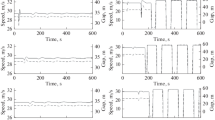Abstract
Many car-following models have been developed for jam avoidance in highways. Two mechanisms are used to improve the stability: feedback control with autonomous models and increasing of the interaction within cooperative ones. In this paper, we compare the linear autonomous and collective optimal velocity (OV) models. We observe that the stability is significantly increased by adding predecessors in interaction with collective models. Yet, autonomous and collective approaches are close when the speed difference term is taken into account. In the linear OV models tested, the autonomous models including speed difference are sufficient to maximise the stability.
Access this chapter
Tax calculation will be finalised at checkout
Purchases are for personal use only
Similar content being viewed by others
References
Bando, M., Hasebe, K., Nakayama, A., Shibata, A., Sugiyama, Y.: Dynamical model of traffic congestion and numerical simulation. Phys. Rev. E 51(2), 1035–1042 (1995)
Davis, L.C.: Effect of adaptative cruise control systems on traffic flow. Phys. Rev. E 69, 066110 (2004)
Hasebe, K., Nakayama, A., Sugiyama, Y.: Dynamical model of a cooperative driving system for freeway traffic. Phys. Rev. E 68, 026102 (2003)
Hu, Y., Ma, T., Chen, J.: An extended multi-anticipative delay model of traffic flow. Commun. Nonlinear Sci. Numer. Simul. 19(9), 3128–3135 (2014)
Jiang, R., Wu, Q., Zhu, Z.: Full velocity difference model for a car-following theory. Phys. Rev. E 64, 017101 (2001)
Jin, Y., Hu, H.: Stabilization of traffic flow in optimal velocity model via delayed-feedback control. Commun. Nonlinear Sci. Numer. Simul. 18(4), 1027–1034 (2013)
Kesting, A., Treiber, M., Schönhof, M., Helbing, D.: Adaptive cruise control design for active congestion avoidance. Trans. Res. Part C Emerg. Technol. 16(6), 668–683 (2008)
Kesting, A., Treiber, M., Schönhof, M., Kranke, F., Helbing, D.: Jam-avoiding adaptive cruise control (ACC) and its impact on traffic dynamics. In: Traffic and Granular Flow’05, pp. 633–643 (2007)
Konishi, K., Kokame, H., Hirata, H.: Coupled map car-following model and its delayed-feedback control. Phys. Rev. E 60, 4000–4007 (1999)
Konishi, K., Kokame, H., Hirata, K.: Decentralized delayed-feedback control of an optimal velocity traffic model. Eur. Phys. J. B-Condens. Matter Complex Syst. 15(4), 715–722 (2000)
Lenz, H., Wagner, C., Sollacher, R.: Multi-anticipative car-following model. Eur. Phys. J. B-Condens. Matter Complex Syst. 7(2), 331–335 (1999)
Monteil, J., Billot, R., Sau, J., El Faouzi, N.E.: Linear and weakly nonlinear stability analyses of cooperative car-following models. IEEE Trans. Intell. Trans. Syst. 15(5), 2001–2013 (2014)
Nakayama, A., Sugiyama, Y., Hasebe, K.: Effect of looking at the car that follows in an optimal velocity model of traffic flow. Phys. Rev. E 65, 016112 (2001)
Treiber, M., Kesting, A.: Traffic Flow Dynamics. Springer, Berlin (2013)
Wilson, R., Berg, P., Hooper, S., Lunt, G.: Many-neighbour interaction and non-locality in traffic models. Eur. Phys. J. B-Condens. Matter Complex Syst. 39(3), 397–408 (2004)
Zhao, X., Gao, Z.: Controlling traffic jams by a feedback signal. Eur. Phys. J. B-Condens. Matter Complex Syst. 43(4), 565–572 (2005)
Author information
Authors and Affiliations
Corresponding author
Editor information
Editors and Affiliations
Rights and permissions
Copyright information
© 2016 Springer International Publishing Switzerland
About this paper
Cite this paper
Tordeux, A., Lassarre, S. (2016). Jam Avoidance with Autonomous Systems. In: Knoop, V., Daamen, W. (eds) Traffic and Granular Flow '15. Springer, Cham. https://doi.org/10.1007/978-3-319-33482-0_52
Download citation
DOI: https://doi.org/10.1007/978-3-319-33482-0_52
Published:
Publisher Name: Springer, Cham
Print ISBN: 978-3-319-33481-3
Online ISBN: 978-3-319-33482-0
eBook Packages: Mathematics and StatisticsMathematics and Statistics (R0)




